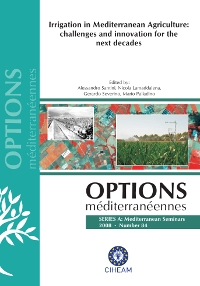| Article précédent | p. 69-75 | Article suivant |
Crop water status estimated by remote sensing information
Techniques to more accurately quantify crop water status are needed for determining crop water requirements and appropriate irrigation scheduling. Remote sensing techniques are a possible tool for estimating the crop water status. To verify this hypothesis, in 2007 a measurement campaign was carried out in Rutigliano (lat. 41°01' N, long. 17°01 E, alt. 147m a.s.l.), with the tomato as the test crop. This crop was subjected to three irrigation treatments. To monitor the water status, both remote sensing (NDVI and radiative surface temperature) and manual measurements (stomatal conductance and pre-dawn leaf water potential (PLWP)) were used. The NDVI index is a function of both crop growth (LAI and biomass) and the crop water status. The experimental data showed a linear relationship between PLWP and NDVI. From this relationship it seems possible to predict the crop water status starting from completely automatic measurements. Although additional research is needed, the remote sensing technique potentially offers an improvement of the irrigation scheduling.
Des techniques capables de quantifier d'une manière précise l'état hydrique des plantes cultivées sont nécessaires, afin de déterminer les besoins en eau des plantes ainsi que le programme à adapter pour le pilotage de l'irrigation. La télédétection est un instrument possible pour évaluer l'état hydrique des plantes. Pour vérifier cette hypothèse, une campagne de mesures a été menée en 2007 à Rutigliano (lat. 41°01' N, long. 17°01 E, alt. 147m), sur une culture de tomates. La parcelle cultivée a été soumise à trois traitements d'irrigation. Afin de suivre de près l'état hydrique de la plante, la télédétection (NDVI et température de surface radiative) ainsi que les mesures manuelles (conductance stomatique et potentiel hydrique foliaire de base PLWP) ont été utilisées. L'indice NDVI est une fonction de la croissance (LAI et biomasse) ainsi que de l'état hydrique des plantes. Les données expérimentales ont montré une relation linéaire entre PLWP et NDVI. De cette relation, il semble possible de prévoir l'état hydrique des cultures à partir de mesures complètement automatiques. Bien qu'une recherche supplémentaire soit nécessaire, la télédétection offre potentiellement une amélioration de la programmation de l'irrigation.
- [ Afficher ]
- [ Télécharger ]
- [ Exporter la citation ]
Vous pouvez télécharger la citation au format :
- [ Imprimer ]
-
Mots-clés
BESOIN EN EAU, BILAN HYDRIQUE, IRRIGATION, MESURE, RELATION PLANTE EAU, TELEDETECTIONCiter cet article
Palumbo A.D., Campi P., Modugno F., Mastrorilli M. Crop water status estimated by remote sensing information. In : Santini A. (ed.), Lamaddalena N. (ed.), Severino G. (ed.), Palladino M. (ed.). Irrigation in Mediterranean agriculture: challenges and innovation for the next decades. Bari : CIHEAM, 2008. p. 69-75. (Options Méditerranéennes : Série A. Séminaires Méditerranéens; n. 84). International Conference on Irrigation in Mediterranean Agriculture: Challenges and Innovation for the Next Decades, 2008/06/17-18, Naples (Italy). http://om.ciheam.org/om/pdf/a84/00800952.pdf



